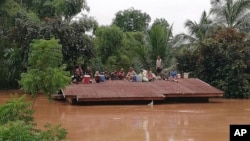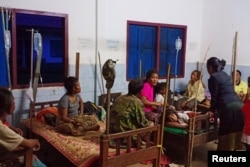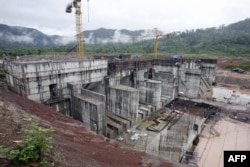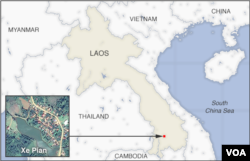Non-government organizations and researchers are calling on the Lao Government to ensure transparency in its investigations on Lao populations affected by massive flooding from a breach in a hydropower dam wall that left more than two dozen people dead last month in southern Laos.
The southern Lao township of Attapeu, bore the brunt of a wall of water after the July 23 collapse of a portion of the Xe Pian Xe Namnoy hydropower dam. In addition to the dead many people are missing, with at least 6,000 displaced by the torrent.
Keith Barney, a specialist in environmental research and natural resource policy in South East Asia at Australia’s National University, says when faced with disasters and other tragedies governments will move to close down sources of information.
"The tendency in many cases when faced with difficult issues or external criticism is to cover up and shut down and block out the flow of information, and there are indications that some of that is underway, but this will be certainly raising significant questions and criticisms of the strategy," Barney told VOA.
Satellite images show Attapeu lying on a bend of the river with a pre-crisis network of roads, but a later image shows the flooded area as a brown mass of mud with few structures left recognizable.
Barney says, “These are very vulnerable people. Many of them ethnic minorities that have already been significantly affected from the original dam construction process, either through the downstream impact or through resettlement and this will just be adding on to their vulnerability in the coming year."
The 410-megawatt Xe Pian-Xe Nam Noy hydropower dam near the Cambodian border is part of a series of dams Laos has planned or built to bolster its economy as the “light bulb of South East Asia” through sales of electricity to neighboring countries.
Non-governmental organizations have been vocal opponents of Laos’ rush to hydro development without adequate assurances over the social and environmental impacts from such projects.
The Xe-Pian-Xe Nam Noy region feeds into the Sekong River, considered “one of the Mekong’s most important tributaries,” according to the non-governmental group Save the Mekong.
The Sekong’s waters and other smaller tributaries are home “to tens of thousands of people from at least 20 different ethnic groups, all of whom rely on wild capture fisheries and surrounding forests and fertile lands” for food, according to the group's statement.
The coalition of NGOs says much of Laos and the Mekong are “vulnerable to such disasters and to broader environmental threats due to 11 large hydropower dams on the lower Mekong mainstream, and 120 tributary dams planned by 2014.
“This disaster has amplified calls from within Laos to reconsider the country’s heavy investment in hydropower, and to strengthen the enforcement of national laws to ensure greater accountability from foreign investors,” Save the Mekong said.
The group said the hydrological and water quality changes had “decimated local fisheries and villagers living along the Xe Pian River” and who had received “no compensation for the loss of their livelihoods."
Barney says the collapse also raises questions over construction standards on the projects. “I guess it’s a warning over the adequacy of the actual dam construction process, but also in terms of a broader rethinking of the headline strategy into hydropower that Laos and the other regional governments seem to be following. So how the Lao government responds will be very critical,” he said.
Aid has poured in to assist Laos with recovery and redevelopment from the tragedy. South Korea, Singapore, Vietnam, Malaysia and Australia have provided funding and resources for the effort.
The intergovernmental Mekong River Commission, in a statement to VOA, said the commission is “working to develop short- and medium-term programs to support Laos and other countries on dam safety in collaboration with the U.S. Army Corps of Engineers."
The programs would cover post failure dam assessment and analyses, reviews of dam construction, external reviews and establishing a national dam safety program.










